|
TRS Tech Library Side Menu
|
Semi-floating or full-floating?
From the factory, stock axle assemblies came in either semi-floating or
full-floating designs. On a semi-floating axle, the wheel attaches
directly to its outer end, and the weight of the vehicle, as well as its
engine power, are channeled through a single bearing set at the end of the
axle. The full-floater, the stronger of the two designs, attaches the axle
to a separate hub, and two larger bearing sets support the weight of the
vehicle. This means that the axle is only used to drive engine power
through the axle. The upside to the semi-floating axle design is that the
aftermarket has responded with a full-floater conversion for almost every
type of semi-floating axle.
|
Ford
Axles: |
| Ford 7.5-Inch |
| Photo: |
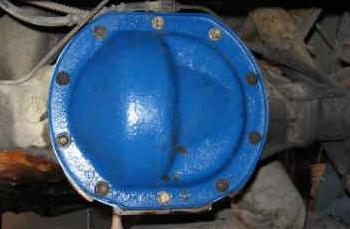 |
|
Application: |
Rear |
|
Type: |
Semi-floating |
| Axle
Shaft Diameter: |
1.2 Inches |
| Spline count: |
28 |
| Ring Gear Diameter: |
7.5 Inch |
|
Maximum tire size for stock axle: |
33-inch |
|
Strong point: |
Approximately the same pinion diameter as a Dana 60,
mass availability. |
|
Weak point: |
C-clips. |
| Notes: |
For more on Ranger rear axles click HERE. |
| Ford 8.8-Inch |
| Photo: |
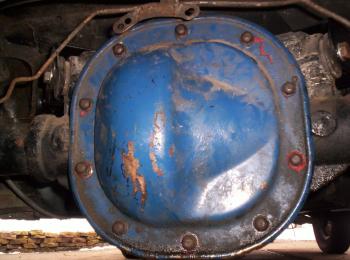 |
| Application: |
Rear |
| Type: |
Semi-floating |
|
Axle
Shaft Diameter: |
1.31 Inches |
| Spline count: |
28, 31 |
| Ring Gear Diameter: |
8.8 Inch |
| Factory ratios: |
2.47:1 through 4.10:1 |
| Maximum tire size for stock axle: |
37-inch |
| Strong point: |
Approximately the same pinion diameter as a Dana 60,
mass availability |
| Weak point: |
C-clips |
| Junkyard jewel: |
Look for fullsize Ford trucks made after late '86
with ABS because these axles had a larger 7/8-inch-diameter cross pin.
Also look for late-model Explorers equipped with these axles because they
have disc brakes and 31-spline axles. |
| Building secrets: |
The stock diff cover is very thin, so replace it
with a quality aftermarket cover. Also, apply silicone to the pinion
splines because some builders have found that they're prone to leaking |
| Aftermarket alternatives: |
Currie Industries, Custom Differentials,
DTS Custom Service, Mountain Off Road Enterprises |
| Notes: |
An Explorer 8.8-inch is a popular swap for TJ Wranglers because it's
almost exactly the same width as the stock Wrangler axles and thus
requires no width modifications. Further, Alan at Mountain Off Road
Enterprises says that the Explorers used the same wheel bolt pattern as
a TJ. Other vehicles that used the 8.8-inch axle included Ford ½-ton
trucks from '80 to present, and Mustang GTs. |
| Ranger VS Explorer: |
The
Rangers use a 28-spline 8.8-Inch axle on 4.0 Liter engine applications and
a 31-spline axle on FX4 applications. All Explorer's are equipped
with a 31-spline 8.8-Inch axle. |
| Notes: |
For
more on Ranger axles click HERE. |
| Ford
9-Inch |
| Photo: |
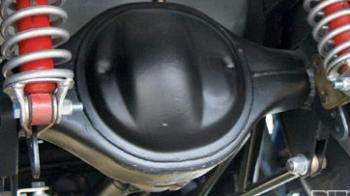 |
| Application: |
Rear |
| Type: |
Semi-floating |
|
Axle
Shaft Diameter:
|
1.19 and 1.33 Inches
|
| Spline count: |
28 or 31 |
| Ring Gear Diameter: |
9 Inch |
| Factory ratios: |
2.50:1 through 4.56:1 |
| Maximum tire size for stock axle: |
37-inch |
| Strong point: |
Removable third member allows for easy
upgradeability,
can upgrade to larger-diameter pinion |
| Weak point: |
Difficult to remove third member if an axleshaft
breaks, stock pinion-shaft diameter is smallish |
| Junkyard jewel: |
They're hard to find, but some Ford ½-ton 4x4
pickups were equipped with an optional nodular-iron 9-inch, which was
stronger and offered less chance of bearing-cap failure |
| Building secrets: |
Replace the crush sleeve in the pinion bearing
with solid spacers and shim kit. This eliminates the movement of the
pinion shaft under hard load |
| Aftermarket alternatives: |
Currie Enterprises, Custom Differentials,
DTS Custom Service, National Drivetrain Inc., Randy's Ring & Pinion |
| Notes: |
Be careful when hunting for a 9-inch
in junkyards because they are cosmetically similar to the weak (and
expensive) Ford 8-inch axle. Also beware of the 9 3/8-inch axles in
Lincoln cars because they also look similar but take a different axle
length on one side due to their slightly offset housing.
For more information, click HERE.
|
| Ford 10-1/2
|
| Photo: |
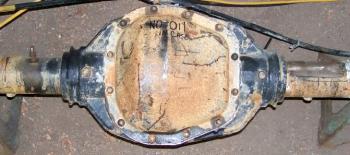 |
| Application: |
Rear |
| Type: |
Full-floater |
| Axle
Shaft Diameter: |
1.5 Inches |
| Spline count: |
35 |
| Ring Gear Diameter: |
10.5 Inch |
| Factory ratios: |
3.08:1 through 4.10:1 |
| Maximum tire size for stock axles: |
44-inch |
| Strong point: |
Large teeth on ring-and-pinion, mass availability |
| Weak point: |
Ring-gear bolts tend to loosen |
| Junkyard jewel: |
Use an axle out of a '99-or-newer Ford truck
because they sported disc brakes |
| Building secrets: |
The stock ring-gear bolts are notorious for
loosening due to their design, which omits a shoulder on the bolts.
Custom Differentials uses Dana 70 ring-gear bolts, which have shoulders
and won't loosen |
| Aftermarket alternatives: |
Custom Differentials |
| Notes: |
This axle debuted in the early '80s in ¾- and 1-ton Ford pickups and
vans, including dualies. Their popularity with builders took awhile to
grow, due to the slow availability of aftermarket gears and parts. One of
the reasons was that most Sterling axles manufactured after '87 used ABS
senders in the differentials, which limited their upgradeability. One of
the neat things about Sterling axles is the unique O-ring design on the
axleshafts, which are less likely to leak when compared to standard
gaskets |
|
Dana
Axles: |
| Dana 28 TTB
|
| Photo: |
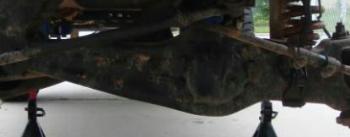 |
| Applications: |
Front |
| Axle
Shaft Diameter:
|
1.0 Inches
|
| Spline count: |
23 |
| Ring Gear Diameter: |
6.625 Inch |
| Maximum tire size for stock axle: |
31-inch |
| Strong
Points: |
Light
weight making it good for mud. Can easily be made to produce
very good articulation with only the addition of longer radius arms
and custom coils. |
| Weak
Points: |
Outer
axle shafts break. Radius arm bushings- especially passenger
side frequently need replacing due to being too close to the
catalytic converters. Brakes have a tendency to warp and/or
crack the front rotors. Steering the stock steering set-up is
very poor for a lifted truck. Severe bump steer is usually the
result, in the higher lifts (4" and up) |
| Notes: |
For more information on Dana 28's and Dana 35's, click HERE. |
|
Dana 30 |
| Photo: |
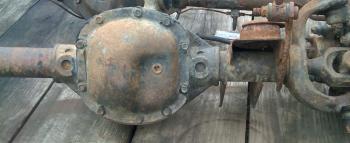 |
| Application: |
Front |
| Axle shaft diameter: |
1.16
Inch |
| Spline count: |
27 |
| Ring gear diameter: |
7.2
Inch |
| Maximum tire size for stock
axles: |
31-inch |
| Weak points: |
Very
weak. Should be replaced with the Dana 44. For more
information, click HERE. |
|
Dana 35 |
| Photo: |
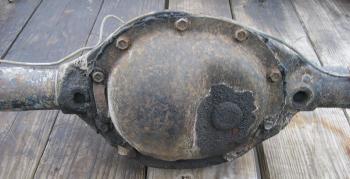 |
| Application: |
Rear |
| Type: |
Semi-floating |
| Axle shaft diameter: |
1.16
Inch |
| Spline count: |
27 |
| Ring gear diameter: |
7.56
Inch |
| Maximum tire size for stock axles: |
33-inch |
| Dana
35 TTB
|
| Photo: |
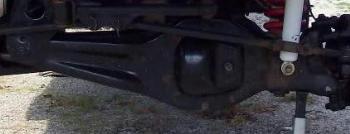 |
| Applications: |
Front |
| Axle
Shaft Diameter:
|
1.16 Inches
|
| Spline count: |
27 |
| Ring Gear Diameter: |
7.56 Inch |
| Maximum tire size for stock axle: |
33-inch |
| Strong
Points: |
Same
knuckles and u-joints as Dana 44. 7.5" R&P are very
strong. Have heard of virtually no failures. Can easily be
lifted. Can easily be made to produce very good articulation
with only the addition of longer radius arms and custom coils.
Good aftermarket support, with many companies making lifts of all
different sizes. Actually has hubs. Entire assembly is
very strong |
| Weak
points: |
Wheel
bearings- though large, are placed too close together.
Automatic hubs- prone to grenading, or giving up when you need them
most. Also, only very coarse adjustment available for wheel
bearings. Radius arm bushings- especially passenger side
frequently need replacing due to being too close to the catalytic
converters. Brakes have a tendency to warp and/or crack the
front rotors. Steering the stock steering set-up is very poor
for a lifted truck. Severe bump steer is usually the result, in the
higher lifts (4" and up) |
| Notes: |
For more information on
Dana 28's and Dana 35's, click HERE. |
| Dana 44 &
Dana 44 TTB |
| Photo: |
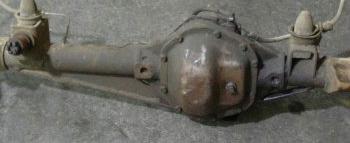
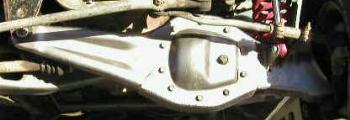
|
| Applications: |
Front and rear |
| Type: |
Mainly semi-floating, although there were some very rare
full-floating units |
| Axle
Shaft Diameter: |
1.30 Inches |
| Spline count: |
30 (after '72; prior to '72, some were
19-spline) |
| Ring Gear Diameter: |
8.5 Inch |
| Factory ratios: |
2.76:1 through 5.89:1 |
| Maximum tire size for stock axle: |
35-inch |
| Weight (solid axle): |
240
Pounds |
| Strong point: |
Wide availability and significant aftermarket support
in parts and upgrades |
| Weak point: |
Carrier and spider gears, U-joints, ring-and-pinion |
| Junkyard jewel: |
Find a front axle out of an early '80s Dodge
3/4-ton because they were equipped with locking hubs. Also, a front axle
out of a '76-or-earlier ½- or ¾-ton Chevy has steering knuckles that are
cast flat and easily adaptable to crossover steering |
| Building secrets: |
Upgrade the stock carrier and spider gears
because they're notoriously weak. Also, if you've indexed the axle to
improve pinion angle, use a diff cover from a '78 or '79 Ford ¾-ton
high-pinion '44 because it allows for a larger quantity of lube and a
higher fill point |
| Aftermarket alternatives: |
Currie Enterprises, Custom Differentials,
DTS Custom Service, Dynatrac |
| Notes: |
They came in both low-pinion and high-pinion models, and the
centersection was even used in '80-and-up Ford Twin-Traction-Beam
applications. They were offered in 5-, 6-, or 8-lug bolt patterns.
Dana 44 TTB information - Click HERE.
Dana 44 information - Click HERE.
|
| Dana
50 TTB |
| Photo: |
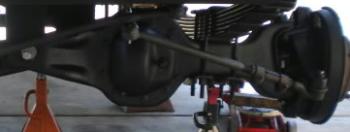 |
| Applications: |
Front |
| Axle shaft diameter: |
1.31
Inch |
| Spline count: |
30 |
| Ring gear diameter: |
9.25
Inches |
| Maximum tire size for stock axles: |
36-Inch |
| Dana 60 |
| Photo: |
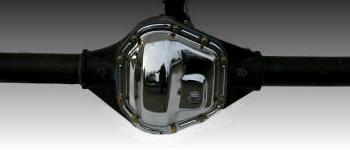 |
| Applications: |
Front and rear |
| Type: |
Semi- and full-floating |
| Ring Gear Diameter |
9.75" (Rear)
10.10" (Front) |
| Spline count: |
16, 23, 30, 32 and
35 |
| Factory ratios: |
3.54:1 through 7.17:1 |
| Maximum tire size for stock axle: |
38.5-inch |
| Weight: |
505 Pounds |
| Strong point: |
Available in a variety of widths, most of which
were full-floaters |
| Weak point: |
The driver-side carrier bearing was known to spin on
the carrier and this often spun the race, which can damage the housing |
| Junkyard jewel: |
A heavy-duty front '60 can be found on '78 and
'79 ¾-ton Ford pickups equipped with the snowplow package. Some late
'70s and early '80s Dodge trucks had 35-spline '60 rear axles. Rear '60s
are easy to find |
| Building secrets: |
The spider-gear roll pin is small and hollow,
and is prone to breakage. Builders often double up the roll pin for
extra strength (slide one inside of another). Also, replace the pinion
yoke with a 1350-series yoke for extra strength. Finally, be careful
about the spline count. Look for the 32- and 35-spline axles, avoid the
16s and 23s |
| Aftermarket alternatives: |
Currie Enterprises, DTS
Custom Service, Dynatrac, Custom Differentials |
| Notes: |
The venerable '60 has been available in either high- or low-pinion
designs and was never used in an IFS application. Custom Differentials
warns to steer clear of the rare but virtually identical Dana 61 because
most of the parts are not interchangeable |
| Dana 70 |
| Photo: |
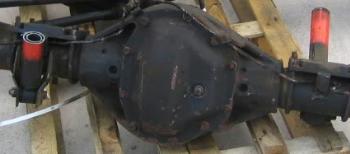 |
| Applications: |
Front and rear |
| Type: |
Most full-floating with some rare semi-floating in
commercial applications |
| Spline count: |
23, 32 or 35 |
| Factory ratios: |
3.54:1 through 7.17:1 |
| Maximum tire size for stock axle: |
44-inch |
| Strong point: |
Large teeth on ring-and-pinion |
| Weak point: |
Small diameter pinion shaft (same as found on Dana
60) |
| Junkyard jewel: |
Rarely seen but known to exist are open-knuckle
front axles with disc brakes. A rear heavy-duty '70 was fitted under
'73-'91 Chevy dualie pickups, and it has larger-than-normal carrier
bearings |
| Building secrets: |
When rebuilding, make sure that any stock
oil-restricting device is left in the pinion area. This keeps lube in
the pinion-bearing area at a higher level and retains it longer. Custom
Differentials says that a number of '70s come to them with the
oil-restricting devices removed |
| Aftermarket alternatives: |
Dynatrac, Custom Differentials |
| Notes: |
One of the benefits to a '70 is that there are a number of
different pinion yoke sizes available, including a 1410-series yoke. Be
careful though, because different housing castings used different sizes of
pinion bearings due to different sizes of pinion bores. |
|
GM
Axles
|
| GM 10-Bolt |
| Photo: |
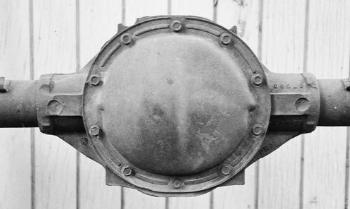 |
| Applications: |
Front and rear |
| Type: |
Semi-floating |
| Spline count: |
28 and 30 |
| Factory ratios: |
2.56:1 through 4.56:1 |
| Maximum tire size for stock axle: |
35-inch |
| Strong point: |
Strong ring-and-pinion for its size, large
ring-gear bolts, spider gears and pinion diameter (when compared to its
competition, the Dana 44) |
| Weak point: |
Avoid the centrifugal-force-triggered
Gov-Lok locker |
| Junkyard jewel: |
Find a 10-bolt-equipped Chevy Blazer or Suburban
built after November 1989 through 1991 because it will have 30-spline
axleshafts |
| Building secrets: |
The axletubes can spin on the
centersection, so
notch the housing where the axletube meets the centersection and re-weld |
| Aftermarket alternatives: |
Custom Differentials. |
| Notes: |
Unfairly, this axle has been the redheaded stepchild in the family of GM
axles. Why is this unfair? Because it boasts an inner pinion bearing
that is stronger than the one found in a 12-bolt axle, and the
pinion-shaft diameter is also larger. Before you run out and snag a
10-bolt, though, be aware that GM offers seven different variations of
this axle. |
| GM 12-Bolt |
| Photo: |
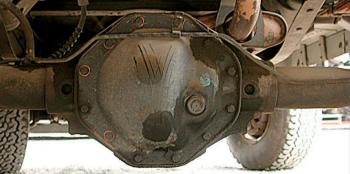 |
| Application: |
Rear |
| Type: |
Semi-floating |
| Spline count: |
30 (after '68.) |
| Factory ratios: |
2.50:1 through 4.56:1 |
| Maximum recommended tire size for stock axle: |
35-inch |
| Strong point: |
Larger-diameter ring gear than 10-bolt (8.875-inch) |
| Weak point: |
The pinion bearings are small and fail often |
| Junkyard jewel: |
Some '76-or-older Chevy ½-ton trucks had a good
Eaton coil-spring-type limited-slip |
| Building secrets: |
Some ratios allow the use of a 12-bolt
automobile gearset, which, interestingly, uses a larger-diameter pinion
shaft |
| Aftermarket alternatives: |
Currie Enterprises, Custom
Differentials, DTS Custom Service |
| Notes: |
This axle was manufactured in both 5- or 6-lug bolt patterns. If you
trash the 12-bolt in your '73-to-early-'80 4x4 Chevy truck, you'll be
happy to know that you can simply install your 6-lug axleshafts into a
two-wheel-drive 12-bolt axle and return to the trail. |
|
GM 14-Bolt
|
| Photo: |
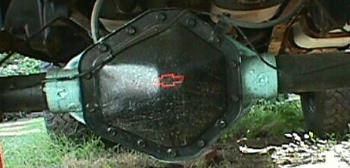 |
| Application: |
Rear |
| Type: |
Semi-floating |
| Spline count: |
30, 33 |
| Factory ratios: |
3.23:1 through 5.14:1 |
| Maximum tire size for stock axle with 10½-inch ring gear: |
44-inch |
| Strong point: |
It features a removable pinion support and a pilot
bearing at the end of the pinion shaft for added strength |
| Weak point: |
The left-side carrier cap is known to break through
the bolt hole |
| Junkyard jewel: |
Find one on a '73-to-current ¾- or 1-ton Chevy
truck. The newer the axle, the better |
| Building secrets: |
Replace the Gov-Lok diff with an aftermarket
unit |
| Aftermarket alternatives: |
Custom Differentials. |
| Notes: |
The GM 14-bolt came in both a 9½-inch ring gear and a 10½-inch ring
gear, and they're totally different animals. The latter is the more
desirable, and its only resemblance to the 9½-inch is the number of
cover bolts. |
|
Rockwell
|
| Rockwell 2-1/2 Ton
|
| Photo: |
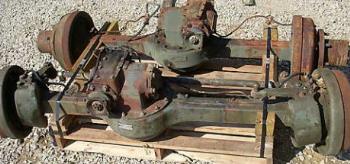 |
| Application: |
Front and rear |
| Type: |
Full-floater |
| Spline count: |
16 |
| Factory ratio: |
6.72 |
| Maximum tire size for stock axles: |
40-inch and above (limited by
gear ratio) |
| Weight: |
640 Pounds |
| Strong point: |
There are many, but for builders, the high entry
position of the driveshaft is a major plus when engineering the
drivetrain and it offers improved ground clearance |
| Weak point: |
Only one ratio available. |
| Junkyard jewel: |
Find a later model that is equipped with Spicer
U-joints and avoid the earlier models with Bendix and Rezepa axle
joints. |
| Building secrets: |
Add a Detroit Locker |
| Aftermarket alternatives: |
Boyce Equipment, Chuck's Trucks. |
| Notes: |
What can you say about an axle that has been used by the military for
years, is readily available and can stand up to just about any abuse you
can dish out? Sure, it's heavy and only comes in one gear ratio, but for
the serious 'wheeler who runs big tires on brutal terrain, it's the Holy
Grail.
Visit Boyce
Equipment and Chuck's Trucks for more information.
|
|
Unimog
Portal Axles |
| |
|
| Photo: |
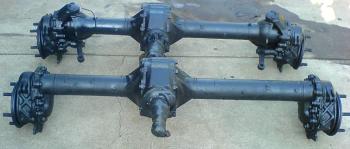 |
| Application: |
Unimog 404, 406, 416,
435 |
| Type: |
Portal axle with
reduction hub |
| Factory Ratio [406, 416,
435] |
6:52 [3.14 Ring
Gear + 2.07 Hub Reduction]
6:06 [3.14 Ring Gear + 1.92
Hub Reduction]
5:31 [ 2.55 Ring Gear + 2.07
Hub Reduction] [High Speed Axles] |
| Factory Ratio [404]: |
7.56 [3.54 Ring
Gear + 2.13 Hub Reduction] |
| Maximum tire size for stock
404 axles: |
42-inch |
| Wheel Bolt Pattern: |
6x205mm |
| Strong Point: |
Strong axles. A lot of
ground clearance |
| Weak Point: |
Expensive. Hard to find.
Hard to find parts for. |
|